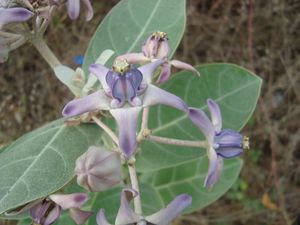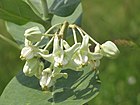Note: This is a project under development. The articles on this wiki are just being initiated and broadly incomplete. You can Help creating new pages.
Difference between revisions of "Calotropis gigantea - Arka plant"
(Prabhakar moved page Arka (Calotropis procera Ait) to Calotropis procera Ait - Arka) |
(→References) |
||
| (56 intermediate revisions by 2 users not shown) | |||
| Line 1: | Line 1: | ||
| − | + | [[File:"Calotropis flower".JPG|thumb|right|'' Sadapushpa'', ''Mandara'', ''Calotropis flower'']] | |
| + | '''Calotropis procera''' is a large shrub growing to 4m tall. It has clusters of waxy flowers that are either white or lavender in color. This plant is belongs to Aslepiacea family. | ||
| + | ==Uses== | ||
| + | {{Uses|Rheumatism}}, {{Uses|Painful joints}}, {{Uses|Skin blemishes}}, {{Uses|Leucoderma}}, {{Uses|Vitiligo}}, {{Uses|Piles}}, {{Uses|Pain in ears}}<ref name="Uses"/> | ||
| + | |||
| + | ==Parts Used== | ||
| + | {{Parts Used|Roots}}, {{Parts Used|Bark}}, {{Parts Used|Flowers}}, {{Parts Used|Leaves}}, {{Parts Used|Latex}}. | ||
| + | |||
| + | ==Chemical Composition== | ||
| + | The milky sap contains a complex mix of chemicals, some of which are steroidal heart poisons known as "cardiac aglycones".<ref name="Chemical Composition"/> | ||
| + | |||
| + | ==Common names== | ||
| + | {{Common names|sa=Bhaanu, Ravi, Tapana, Arka|en=Aakado|gu=Aakado|hi=Aak, Akavana, Madar|kn=Ekka, Ekkadagida, Ekkegida|ks=Vasa|ml=Erikku|mr=Rui|pa=Ak|ta=Erukku, Vellerukku|te=Jilledu}}<ref name="Common names"/> | ||
| + | |||
| + | ==Properties== | ||
| + | Reference: Dravya - Substance, Rasa - Taste, Guna - Qualities, Veerya - Potency, Vipaka - Post-digesion effect, Karma - Pharmacological activity, Prabhava - Therepeutics. | ||
| + | ===Dravya=== | ||
| + | |||
| + | ===Rasa=== | ||
| + | Tikta (Bitter), Katu (Pungent) | ||
| + | ===Guna=== | ||
| + | Laghu (Light), Sara, Snigdha | ||
| + | ===Veerya=== | ||
| + | Ushna (Hot) | ||
| + | ===Vipaka=== | ||
| + | Katu (Pungent) | ||
| + | ===Karma=== | ||
| + | Vatahara, Kaphahara, Bhedana, [[Deepana]], Kshamighna | ||
| + | |||
| + | ===Prabhava=== | ||
| + | |||
| + | ==Habit== | ||
| + | {{Habit|Large shrub}} | ||
| + | |||
| + | ==Identification== | ||
| + | ===Leaf=== | ||
| + | {{Leaf|Simple|Opposite|Elliptic-ovate to obovate, greyish-green in colour and have entire margins, relatively thick (5-30 cm long and 4-15 cm wide) with a cordate leaf base. Secondary veins 5-7 pairs}}<ref name="Leaf"/> | ||
| + | |||
| + | ===Flower=== | ||
| + | {{Flower|Borne in clusters|15-25 mm across|White or Purplish|Five|Flowering occurs mostly during winter}} | ||
| + | |||
| + | ===Fruit=== | ||
| + | {{Fruit|Large|6-12 cm long and 3-7 cm wide||These fruit have thick and spongy skins which split open at maturity|Flattened seeds|}} | ||
| + | |||
| + | ===Other features=== | ||
| + | |||
| + | ==List of Ayurvedic medicine in which the herb is used== | ||
| + | * [[Vishatinduka Taila]] as ''root juice extract'' | ||
| + | |||
| + | ==Where to get the saplings== | ||
| + | ==Mode of Propagation== | ||
| + | {{Propagation|Seeds}}, {{Propagation|Cuttings}}, {{Propagation|Layering}}. | ||
| + | |||
| + | ==How to plant/cultivate== | ||
| + | Succeeds in the drier tropics. Most commonly found in areas of the tropics with a specific dry season, at elevations up to 1,000 metres.<ref name="How to plant/cultivate"/> | ||
| + | |||
| + | ==Commonly seen growing in areas== | ||
| + | {{Commonly seen|Tropical area}}, {{Commonly seen|Indian subcontinent}}. | ||
| + | |||
| + | ==Photo Gallery== | ||
| + | <gallery class="left" caption="" widths="140px" heights="140px"> | ||
| + | File:Starr 010701-9001 Calotropis procera.jpg|''Calotropis procera'' fruit | ||
| + | File:Calotropis giganteaRHu3.JPG|Buds | ||
| + | File:C. gigantea.JPG|Leaves | ||
| + | File:Starr 070730-7945 Calotropis gigantea.jpg|Floral tassels made from ''Calotropis'' flowers. | ||
| + | </gallery> | ||
| + | |||
| + | ==References== | ||
| + | <references> | ||
| + | <ref name="Leaf">Kappatagudda - A Repertoire of Medicinal Plants of Gadag pdf, Page no - 91</ref> | ||
| + | |||
| + | <ref name="How to plant/cultivate">[http://tropical.theferns.info/viewtropical.php?id=Calotropis+gigantea Cultivation Details]</ref> | ||
| + | |||
| + | <ref name="Uses">[https://www.bimbima.com/herbs/medicinal-uses-of-madar-or-arka/688/ Medicinal uses of Madar]</ref> | ||
| + | |||
| + | <ref name="Chemical Composition">[https://www.researchgate.net/publication/241039494_Chemical_composition_of_Calotropis_gigantea Chemical Composition]</ref> | ||
| + | |||
| + | <ref name="Common names">Karnataka Aushadhiya Sasyagalu By Dr.Maagadi R Gurudeva, Page no:245</ref> | ||
| + | </references> | ||
| + | |||
| + | ==External Links== | ||
| + | * [http://nif.org.in/CALOTROPIS-PROCERA Calotropis procera Ait on national innovation foundation=] | ||
| + | * [https://plants.jstor.org/stable/10.5555/al.ap.upwta.1_478 Calotropis procera Ait on global plants] | ||
| + | * [https://www.ncbi.nlm.nih.gov/pmc/articles/PMC2876921/ Pharmacognostic standardization of leaves of Calotropis procera (Ait.)] | ||
| + | * [http://www.science20.com/humboldt_fellow_and_science/blog/calotropis_procera_ait_rbr_arka_important_drug_ayurveda CALOTROPIS PROCERA (Ait.) R.Br. Arka, an important drug of Ayurveda] | ||
| + | [[Category: Ayurvedic Pharmacopedia of India]] | ||
| + | [[Category:Herbs]] | ||
| + | [[Category:Ayurvedic herbs that don't have seed photos]] | ||
| + | [[Category:Apocynaceae]] | ||
Latest revision as of 15:22, 25 March 2021
Calotropis procera is a large shrub growing to 4m tall. It has clusters of waxy flowers that are either white or lavender in color. This plant is belongs to Aslepiacea family.
Uses
Parts Used
Chemical Composition
The milky sap contains a complex mix of chemicals, some of which are steroidal heart poisons known as "cardiac aglycones".[2]
Common names
| Language | Common name |
|---|---|
| Kannada | Ekka, Ekkadagida, Ekkegida |
| Hindi | Aak, Akavana, Madar |
| Malayalam | Erikku |
| Tamil | Erukku, Vellerukku |
| Telugu | Jilledu |
| Marathi | Rui |
| Gujarathi | Aakado |
| Punjabi | Ak |
| Kashmiri | Vasa |
| Sanskrit | Bhaanu, Ravi, Tapana, Arka |
| English | Aakado |
Properties
Reference: Dravya - Substance, Rasa - Taste, Guna - Qualities, Veerya - Potency, Vipaka - Post-digesion effect, Karma - Pharmacological activity, Prabhava - Therepeutics.
Dravya
Rasa
Tikta (Bitter), Katu (Pungent)
Guna
Laghu (Light), Sara, Snigdha
Veerya
Ushna (Hot)
Vipaka
Katu (Pungent)
Karma
Vatahara, Kaphahara, Bhedana, Deepana, Kshamighna
Prabhava
Habit
Identification
Leaf
| Kind | Shape | Feature |
|---|---|---|
| Simple | Opposite | Elliptic-ovate to obovate, greyish-green in colour and have entire margins, relatively thick (5-30 cm long and 4-15 cm wide) with a cordate leaf base. Secondary veins 5-7 pairs |
Flower
| Type | Size | Color and composition | Stamen | More information |
|---|---|---|---|---|
| Borne in clusters | 15-25 mm across | White or Purplish | Five | Flowering occurs mostly during winter |
Fruit
| Type | Size | Mass | Appearance | Seeds | More information |
|---|---|---|---|---|---|
| Large | 6-12 cm long and 3-7 cm wide | These fruit have thick and spongy skins which split open at maturity | Flattened seeds |
Other features
List of Ayurvedic medicine in which the herb is used
- Vishatinduka Taila as root juice extract
Where to get the saplings
Mode of Propagation
How to plant/cultivate
Succeeds in the drier tropics. Most commonly found in areas of the tropics with a specific dry season, at elevations up to 1,000 metres.[5]
Commonly seen growing in areas
Photo Gallery
References
- ↑ Medicinal uses of Madar
- ↑ Chemical Composition
- ↑ Karnataka Aushadhiya Sasyagalu By Dr.Maagadi R Gurudeva, Page no:245
- ↑ Kappatagudda - A Repertoire of Medicinal Plants of Gadag pdf, Page no - 91
- ↑ Cultivation Details
External Links
- Ayurvedic Herbs known to be helpful to treat Rheumatism
- Ayurvedic Herbs known to be helpful to treat Painful joints
- Ayurvedic Herbs known to be helpful to treat Skin blemishes
- Ayurvedic Herbs known to be helpful to treat Leucoderma
- Ayurvedic Herbs known to be helpful to treat Vitiligo
- Ayurvedic Herbs known to be helpful to treat Piles
- Ayurvedic Herbs known to be helpful to treat Pain in ears
- Herbs with Roots used in medicine
- Herbs with Bark used in medicine
- Herbs with Flowers used in medicine
- Herbs with Leaves used in medicine
- Herbs with Latex used in medicine
- Herbs with common name in Kannada
- Herbs with common name in Hindi
- Herbs with common name in Malayalam
- Herbs with common name in Tamil
- Herbs with common name in Telugu
- Herbs with common name in Marathi
- Herbs with common name in Gujarathi
- Herbs with common name in Punjabi
- Herbs with common name in Kashmiri
- Herbs with common name in Sanskrit
- Herbs with common name in English
- Habit - Large shrub
- Index of Plants which can be propagated by Seeds
- Index of Plants which can be propagated by Cuttings
- Index of Plants which can be propagated by Layering
- Herbs that are commonly seen in the region of Tropical area
- Herbs that are commonly seen in the region of Indian subcontinent
- Ayurvedic Pharmacopedia of India
- Herbs
- Ayurvedic herbs that don't have seed photos
- Apocynaceae




